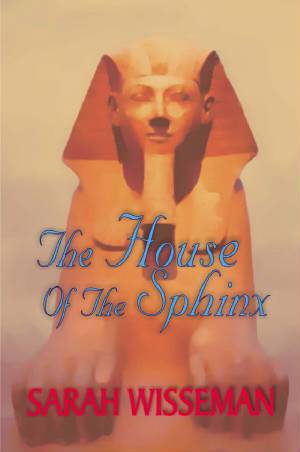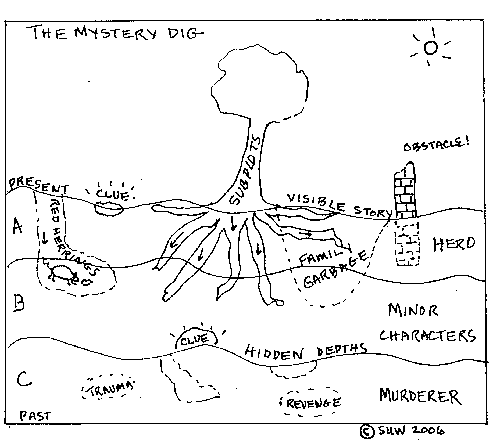 By day, Sarah Wisseman is the director of the Program on Ancient Technologies and Archaeological Materials at the University of Illinois. By night, she’s the author of the Lisa Donahue mystery series, four novels starring a thirty-something archaeologist who seems to stumble onto mystery and murder wherever she happens to be — whether it’s at a museum in Boston, or on an Egyptian tour.
By day, Sarah Wisseman is the director of the Program on Ancient Technologies and Archaeological Materials at the University of Illinois. By night, she’s the author of the Lisa Donahue mystery series, four novels starring a thirty-something archaeologist who seems to stumble onto mystery and murder wherever she happens to be — whether it’s at a museum in Boston, or on an Egyptian tour.
Wisseman didn’t have a clue that she wanted to be an archaeologist until after her freshman year in college, when she traveled to Israel and spent a month at the excavation of biblical Beersheba, but her beginnings as a mystery writer started at an earlier age. When I spoke with her recently, she explained that she’s been fascinated by the genre since childhood: “I grew up in a house where my parents had copies of the old Penguin mysteries, especially the greats, lying all over the place and moldering in the basement.”
Her urge to write mystery novels is apparently genetic, since her father wrote two unpublished mysteries himself.
The character Lisa Donahue is the protagonist of Wisseman’s four novels: Bound for Eternity, The Dead Sea Codex, The Fall of Augustus, and The House of the Sphinx. The first book in the series came out in 2005, the last two just recently. Further details are available at the author’s homepage.
Lisa has a lot in common with her creator. Both are archaeologists, have worked as museum curators, are married to doctors, and have children of their own. Wiseman explained to me that the resemblance is entirely intentional: “She’s pretty autobiographical, and I think that’s something that a lot of beginning fiction writers do, and branch out as they discover they can invent other characters.”
Lisa fits in the category of mystery where the sleuth is usually female, has a college degree, and uses her inquisitive personality and life experience to solve whatever problem she accidentally comes across. Wisseman said of her protagonist, “She fits into the traditional mystery category — or what I would call the ‘cozy’ mystery category — which appeals to a lot of women. Someone who is in the middle of doing a regular job and then stumbles into a mystery or situation and has some kind of motivation — maybe someone she loves has been hurt. There’s something that keeps her going or just because she’s just so darn curious she has to solve it.”
Wisseman created Lisa along the lines of other mysteries which feature a strong female protagonist with a professional career, such as in the Cat Marsala Series mysteries by Barb D’Amato, where the main character is a journalist.
Of Wisseman’s characters, only Lisa and her husband James (who is based on Wisseman’s real-life husband) are based on real people. The other ones are composites of different actual people the author has encountered over the years, and sometimes behave in ways their creator doesn’t expect. Wisseman explained, “I’ve discovered as I write more, the characters take over. They talk to each other. They come up with stuff that I’m not aware I’m working on. I’ll go for a long walk when I’m stuck and stuff will come into my head and I don’t know where it came from. It’s kind of like having voices talk to you … a little bit.”
When it comes to creating her bad guys, Wisseman said, “You’re supposed to make your villain as interesting a person as the protagonist, and that’s a real challenge.”
Archaeology plays a big part in all the Lisa Donahue mysteries. There’s action in museums, the site of Masada, and the ruins of Luxor, among other archaeology-oriented locations. And Wisseman’s doctorate in the subject gives her settings, plots, and scientific and historical asides a lot of credibility. However, she’s also conscious, when writing her fiction, of the danger of putting in too much science and not enough universal appeal, emotion, and plot flow. She’s concerned with the question of, in her own words, “how you inject technical information into a novel without it being boring.”
She explained that, while as a writer it’s good to know what you’re talking about when you incorporate science into a novel for a popular audience, “It has to be done in such a way that it doesn’t distract the reader and helps the story along.”
The first Lisa Donahue mystery, Bound for Eternity, actually has a non-fiction companion book that goes along with it called The Virtual Mummy. The Virtual Mummy describes a project Wisseman worked on at the UI where non-destructive techniques were used to analyze the mummy of a nine-year-old Egyptian child dated to around 100 AD from the Fayum region of Egypt. A team made up in part of UI academics from different departments working with area hospitals used X-ray and CT scans in addition to — for the first time in mummy research — a supercomputer to create three-dimensional images of the mummified child.
Using this experience as a plot device, and the attic museum of the old World Heritage Museum in Lincoln Hall (the precursor to the Spurlock) as an inspiration for the setting, Wisseman wrote her novel. The book took her years to finish, and Wisseman said, “I was hoping it would turn into a series, but since it was my first attempt at fiction writing, I wasn’t sure.”
After a career of scientific writing, being able to make stuff up was liberating, but it took her a while to figure out that it was allowed: “I was so used to non-fiction writing, that I was halfway through the novel before I realized, ‘Hey this is fiction,’ I can do whatever I want.” She was more accustomed to “footnotes, and having to account for everything that we have to in technical articles, where you have to cross every t.“
She elaborated, “In the novel, I let them use a pediatric endoscope, which we weren’t allowed to do in real life in case it damaged the mummy, and find a mummy tag identifying the kid as the son of a Roman wine merchant and an Egyptian woman. So that was completely a fantasy on my part, but it could have happened.
I realized I could change the ending: I could answer some of the questions in fiction that we couldn’t answer in real life: Who was the kid? Was it a boy or a girl? Who were his parents?”
As a “gimmick” the fiction and non-fiction books were marketed together, which worked fairly well. Wisseman explained, “When I’d be at book events, a lot of women would buy the mystery, and their husbands would say, ‘well, I don’t read fiction,” but they’d buy The Virtual Mummy.”
Wisseman sees a definite connection between the type of science she practices and the type of novels she writes. According to her, the two fields have a lot in common. She said, “I’m discovering that there are all kinds of aspects of my profession that I haven’t even begun to mine yet. There are parts of archeology, especially archeological science, that are very much like being a detective. You have to ferret out information, and the whole process of reconstructing a civilization is much like working on a jigsaw puzzle with half of the pieces missing. So, there’s a lot of examining small bits of evidence and trying to extrapolate something reasonable.”
In short, her archeology career makes her more disposed to write mysteries: “It’s not just growing up with mysteries. I see the process of both reading mysteries and constructing them as being similar to the process of archaeology — delving deeper into something.”
 In an online essay, Wisseman wrote and even drew a picture (figure one: The Mystery Dig) about her analogy of “layers.” She explained how in both mysteries and on a dig, you have to sift slowly and carefully through time and character to figure out what really happened: “Archaeologists love layers because layers, or strata, help them understand chronology: the top layer is the most recent and the deepest layer is the oldest. Near the top is the visible, obvious stuff — potsherds or arrowheads — while the hidden goodies — floors, foundations, and lost heirlooms — are underneath.
In an online essay, Wisseman wrote and even drew a picture (figure one: The Mystery Dig) about her analogy of “layers.” She explained how in both mysteries and on a dig, you have to sift slowly and carefully through time and character to figure out what really happened: “Archaeologists love layers because layers, or strata, help them understand chronology: the top layer is the most recent and the deepest layer is the oldest. Near the top is the visible, obvious stuff — potsherds or arrowheads — while the hidden goodies — floors, foundations, and lost heirlooms — are underneath.
Readers love well-constructed mysteries because it’s so much fun to dig down and uncover clues to crime and layers of identity, plot, and subplot.”
Wisseman is currently writing a mystery that’s somewhat different from her earlier ones. For starters, she’s setting Lisa Donahue aside for a new protagonist, a physician, and the action is moving from the Middle East, where it was in previous novels, to right here in central Illinois. Moreover, while the Lisa Donahue novels are set in the present, Wisseman is going back to about 1923 for her work in progress.
She picked that era for a number of reasons. For one, it’s the period when archaeology was becoming an established profession from the early cowboy days of the field, a time which Wisseman described as, “Amateurs running around digging up artifacts, occasionally shooting at each other … wonderful stories.”
Her doctor protagonist is just such an amateur, and is an archaeological enthusiast among the Native American remains and historical sites that Wisseman said can still be found in the vicinity of Champaign County today.
It’s also the age of prohibition, and this figures in the plot as well. In fact, the doctor is “paid in illegal hooch and artifacts — bones, skulls, pottery.” As far as his personal life goes, he has a “German wife in a time when immigrants weren’t popular and a 19-year-old flapper daughter.”
Wisseman’s books are of interest for a number of reasons: she lives and works right here in Champaign-Urbana, the novels are fast-paced and carefully constructed, and the author’s background as a UI archaeologist add other dimensions for the reader to consider. So, if you want to support a local author, enjoy a crafted mystery, or ponder the relationship between science and suspense, head to Jane Addams bookstore and pick up one of Sarah Wisseman’s novels.








